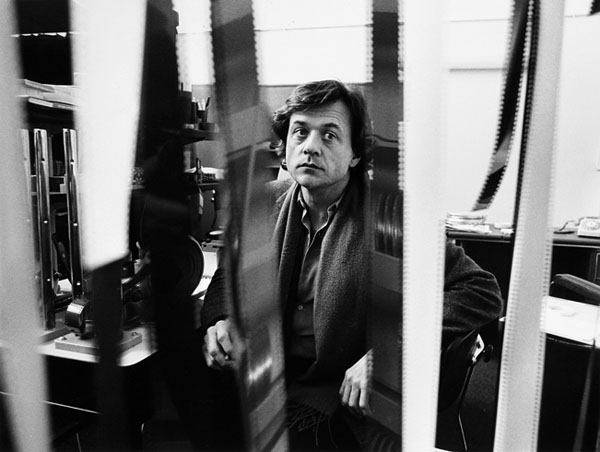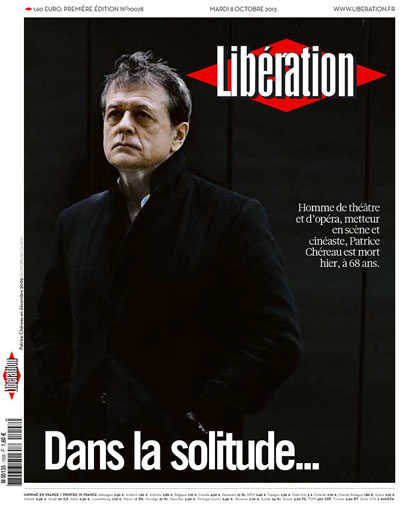“A catastrophe,” declares New Yorker music critic Alex Ross. “Patrice Chéreau died today in Paris, of lung cancer, at the age of 68. The storied director of opera, theater, and film had been undergoing treatment for cancer while preparing his production of Strauss’s Elektra in Aix-en-Provence this past summer; I am told that he continued working despite the enormous physical strain. His contribution to opera, from the epoch-making 1976 Bayreuth Ring onward, was obviously tremendous; if there was a greater living director, the name does not immediately spring to mind.”
In 2001, Chéreau’s Intimacy won the Berlinale’s Golden Bear and the prestigious Prix Louis Delluc, and two years later, he won a Silver Bear for Best Director for Son frère. At Cannes, he won the Jury Prize in 1994 for La reine Margot (Queen Margo, with Isabelle Adjani), then a César for Best Director in 1998 for Ceux qui m’aiment prendront le train (Those Who Love Me Can Take the Train, with Pascal Greggory, Valeria Bruni Tedeschi, Charles Berling, Jean-Louis Trintignant, and on and on).
“When the filmmaker François Reichenbach was dying,” wrote Ed Howard in 2009, “he told his friend, the screenwriter Danièle Thompson, that he was going to be buried in his family plot in the country town of Limoges, and that any of his Parisian friends who really cared would have to take the train to visit him. These words, so charged with meaning and feeling, became the centerpiece of Thompson’s script for Patrice Chéreau’s Those Who Love Me Can Take the Train…. The film is thus a prolonged meditation on death, on friendship, and especially on families, both the ones we’re born into and the ones we make for ourselves with those we meet in life.”
“In the heartbreaking Intimacy, Chéreau observes what happens to a man when he falls in love with the married woman he fucks regularly inside his dingy London flat,” wrote Slant‘s Ed Gonzalez in 2004. “In the elegiac Son frère, he chronicles a desperate reconnect between two brothers when one is diagnosed with a mysterious blood disease…. How good is Chéreau at what he does?… Chéreau bravely lingers on human flesh. However old, taut, hairy, saggy, or cut up, it’s all the same: a gratuitous barrier that too often prevents us from crawling inside each other. The beauty of Chéreau’s films is that they ask us to emotionally transcend that skin.”
Updates, 10/8: “After Flesh of the Orchid (based on a story by James Hadley Chase; two nominations for the César in 1976 for Best Cinematography and Set Design) and Judith Therpauve (nominated for the César for Best Cinematography and Sound in 1979), Patrice Chéreau was selected for the first time in competition in Cannes in 1983 with the incandescent The Wounded Man (which owed him a César for Best Screenplay shared with writer Hervé Guibert),” notes Fabien Lemercier at Cineuropa. “Hotel de France followed in 1987.” Chéreau “was also an actor in six features: Danton by Polish director Andrzej Wajda (1983), Adieu Bonaparte by Egyptian director Youssef Chahine (1985), The Last of the Mohicans by American director Michael Mann (1992), Lucie Aubrac by French director Claude Berri (1997), Nearest to Heaven by Franco-American director Tonie Marshal (2002), and The Time of the Wolf by Austrian director Michael Haneke (2003). And “when he was the president of the jury of the 2003 Cannes Film Festival, Patrice Chéreau bent the rules by awarding the Palme d’Or and the Best Director Award to Elephant by Gus Van Sant.”
David Ng in the Los Angeles Times: “His fluency in both the theatrical and cinematic art forms has invited comparisons to other European greats—Luchino Visconti and Ingmar Bergman.”
David Edelstein has posted a few personal memories and many, many clips.
Ronald Bergan: “Chéreau’s mentors were the great Italian stage director Giorgio Strehler, with whom he worked at the Piccolo Teatro di Milano (1970-72), and Roger Planchon, who appointed the 27-year-old as co-director of the TNP. Among his other influences were Bertolt Brecht, Antonin Artaud and Orson Welles. That said, these influences were seldom reflected in Chéreau’s eclectic filmography. But however one assesses his films, it is obvious that he set out successfully to disconcert audiences.”
Also in the Guardian, Stephen Moss recalls the last time he saw Chéreau when “he had already been diagnosed with cancer. It was in Berlin last April; he looked tired and his hair was thinning.” But on he worked. One evening, “he attended a dinner for eight people, where he was the center of attention. He was witty and nostalgic—reminiscing about trips he made to the seaside with his parents as a boy—and full of life and plans. He must have been utterly spent, yet he chatted for three hours, in English, French and German, dispensing both wine and wisdom…. Obituarists will no doubt concentrate on his achievement in remaking opera with his 1976 Ring at Bayreuth and on his work in the cinema… What might get lost is the sensibility that enabled him to produce this remarkable range of achievements. He invested a great deal of himself in everything he did; he refused to work by rote. He spent seven years developing a film of the life of Napoleon, then abandoned it because he was £7m short of the budget he needed to make the kind of film he wanted.”
Updates, 10/13: “Since Chéreau went to school just 100 meters from the Cinémathèque Française, where he watched Fritz Lang’s M no less than 14 times, the desire to make his own films was planted early,” writes Trevor Johnston for Sight & Sound, “but it was being intoxicated by Kane and Confidential Report, and knowing Orson Welles was initially a man of the theatre, that set the teenage Chéreau on course to span both stage and screen…. Chéreau never wanted to be pigeonholed because of his sexuality, though gay themes were to touch some of his most potent films (Those Who Love Me etc, 2003’s Son Frère). Where L’Homme Blessé did lay down a future marker was the claustrophobic intensity of the camera’s relationship with the performers–including an extraordinary pre-Betty Blue Jean-Hugues Anglade–and the film’s fascination for abrasively unsympathetic characters. He unleashed Anglade once more in La Reine Margot, just one of the unhinged nobility in this feast of sixteenth-century sex, violence and dynastic scheming, which remains the most obviously ‘operatic’ of his films. Showcasing Isabelle Adjani’s imperious diva at the heart of the action, it’s still his best-known title internationally, though his strongest film work was still to come.”
More from David Nice at the Arts Desk.
Update, 10/17: David Ehrenstein presents… Patrice Chéreau Day at DC’s.
For news and tips throughout the day every day, follow @KeyframeDaily on Twitter and/or the RSS feed. Get Keyframe Daily in your inbox by signing in at fandor.com/daily.





